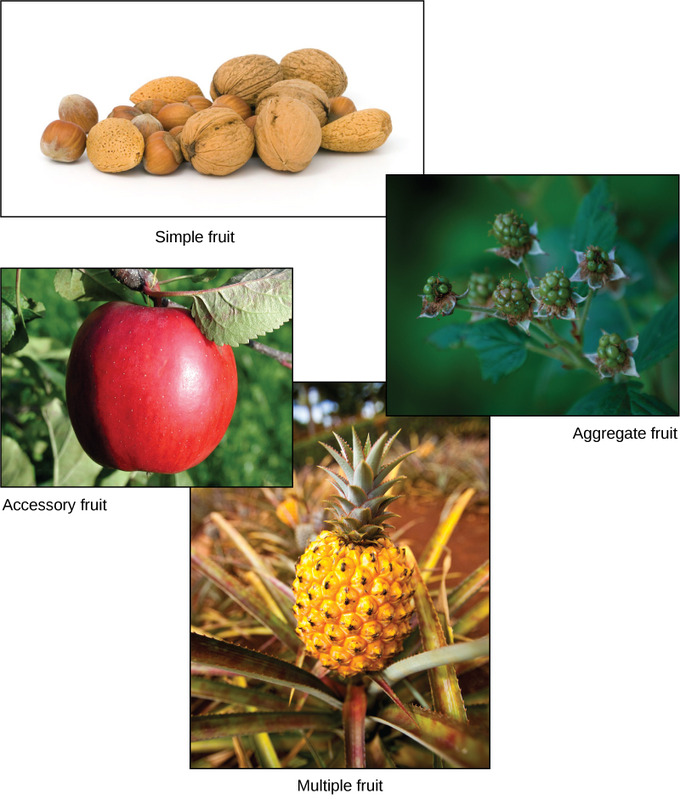32.9: Pollination and Fertilization - Development of Fruit and Fruit Types
- Page ID
- 13809
- Describe the development of a fruit in a flowering plant
After fertilization, the ovary of the flower usually develops into the fruit. Fruits are generally associated with having a sweet taste; however, not all fruits are sweet. The term “fruit” is used for a ripened ovary. In most cases, flowers in which fertilization has taken place will develop into fruits, while unfertilized flowers will not. The fruit encloses the seeds and the developing embryo, thereby providing it with protection. Fruits are diverse in their origin and texture. The sweet tissue of the blackberry, the red flesh of the tomato, the shell of the peanut, and the hull of corn (the tough, thin part that gets stuck in your teeth when you eat popcorn) are all fruits. As the fruit matures, the seeds also mature.

Fruits may be classified as simple, aggregate, multiple, or accessory, depending on their origin. If the fruit develops from a single carpel or fused carpels of a single ovary, it is known as a simple fruit, as seen in nuts and beans. An aggregate fruit is one that develops from numerous carpels that are all in the same flower; the mature carpels fuse together to form the entire fruit, as seen in the raspberry. A multiple fruit develops from an inflorescence or a cluster of flowers. An example is the pineapple where the flowers fuse together to form the fruit. Accessory fruits (sometimes called false fruits) are not derived from the ovary, but from another part of the flower, such as the receptacle (strawberry) or the hypanthium (apples and pears).
Fruits generally have three parts: the exocarp (the outermost skin or covering), the mesocarp (middle part of the fruit), and the endocarp (the inner part of the fruit). Together, all three are known as the pericarp. The mesocarp is usually the fleshy, edible part of the fruit; however, in some fruits, such as the almond, the seed is the edible part (the pit in this case is the endocarp). In many fruits, two, or all three of the layers are fused, and are indistinguishable at maturity. Fruits can be dry or fleshy. Furthermore, fruits can be divided into dehiscent or indehiscent types. Dehiscent fruits, such as peas, readily release their seeds, while indehiscent fruits, like peaches, rely on decay to release their seeds.
Key Points
- Fruits can be classified as simple, aggregate, multiple, or accessory.
- Simple fruits develop from a single carpel or fused carpels of a single ovary, while aggregate fruits develop from more than one carpel found on the same flower.
- Multiple fruits develop from a cluster of flowers, while accessory fruits do not develop from an ovary, but from other parts of a plant.
- The main parts of a fruit include the exocarp (skin), the mesocarp (middle part), and the endocarp (inner part); these three parts make up the pericarp.
- Dehiscent fruits promptly release their seeds, while indehiscent fruits rely on decay to release their seeds.
Key Terms
- exocarp: the outermost covering of the pericarp of fruits; the skin
- simple fruit: fruit that develops from a single carpel or fused carpels of a single ovary
- endocarp: the inner part of the fruit
- mesocarp: middle part of the fruit
- accessory fruit: a fruit not derived from the ovary but from another part of the flower


